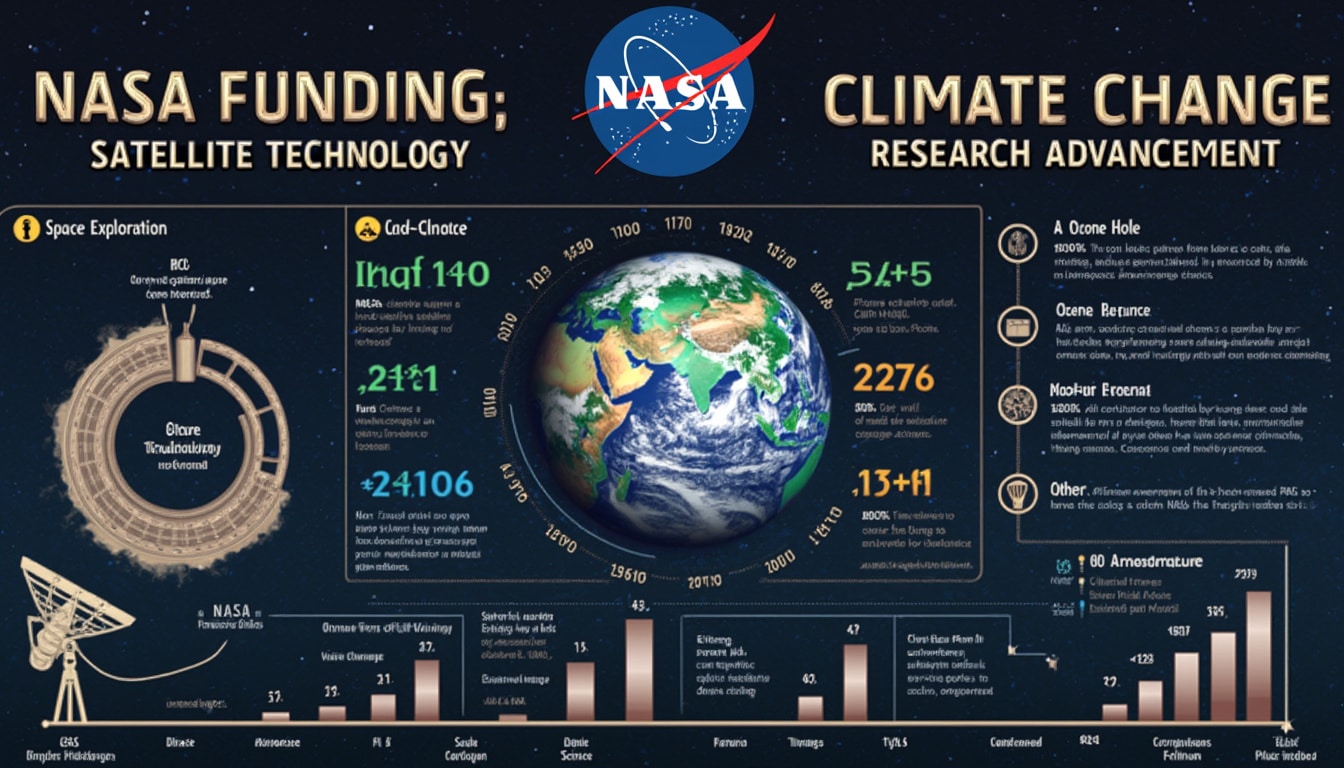Recent discussions surrounding NASA’s budget have cast a shadow over future Earth science missions, raising concerns about significant funding reductions. As the agency navigates complex fiscal challenges, there is anxiety among scientists and researchers about the potential impacts on climate research, environmental monitoring, and satellite technology. These budgetary uncertainties have led to a focus on safeguarding essential missions that contribute to our understanding of climate change and Earth’s ecosystems. The prospect of budget cuts could hinder ongoing and planned projects, creating a ripple effect across various scientific domains.
At a recent congressional roundtable, Representative George Whitesides expressed his worries about the current state of NASA’s Earth science missions, noting that plans for termination have been proposed. This discussion highlights a broader issue as the White House prepares its budget proposals for fiscal year 2026, with suggestions of cuts that could reach an alarming 50% of NASA’s significant $7.3 billion science budget. The uncertain budget landscape has scientists on high alert, concerned for the future of vital scientific innovation and ongoing research grants aimed at monitoring our changing planet.
Understanding the Scope of Potential Budget Cuts
The looming threat of budget cuts at NASA comes at a time when the pursuit of scientific innovation and the need for robust environmental monitoring are more critical than ever. With the recent conversations surrounding funding cuts, the potential impacts on Earth science are becoming increasingly pronounced. As representatives from various sectors of NASA gathered to discuss these issues, it became clear that the agency is in a state of uncertainty regarding its future budgetary allocations.

The Consequences of Cuts to Earth Science
NASA’s Earth science missions play a vital role in the ongoing fight against climate change. They contribute to our understanding of the planet’s systems, from the weather patterns we experience to the numerous ecosystems being affected by fluctuating temperatures. Rep. Whitesides highlighted concerns about plans for terminating missions that have been instrumental in informing policymakers about ecological changes.
For example, satellite technology has revolutionized how we observe environmental changes over time. It allows scientists to gather data on phenomena such as deforestation, ocean circulation, and air quality. A reduction in funding could jeopardize these advancements, stalling critical research that relies heavily on sustained observations from space. Notably, programs focused on climate change forecasting could face severe setbacks, diminishing our capacity to respond effectively to environmental crises.
As discussions continue, it is essential to consider the implications of such funding cuts on various sectors. Not only would researchers face halted projects, but entire teams dedicated to tracking climate impacts would be dismantled. The domino effect could reverberate through the academic community, creating gaps in knowledge that could take years to fill.
The Role of Satellite Technology
Satellite missions have become linchpins in environmental monitoring. Through advanced instruments, satellites provide data that help illuminate how the Earth is changing. Understanding these changes is crucial for both local and global communities, especially for nations vulnerable to climate-related disasters. If budget cuts are enacted, it may directly impact the operational capacities of satellites designed to observe our planet.
NASA’s fleet includes instruments like the Landsat series and the Terra satellite, which provide insights needed for managing natural resources and addressing environmental challenges head-on. The termination of new satellite initiatives or support for existing programs could lead to a scarcity of reliable data — data that authorities depend on for decision-making regarding public safety, resource management, and urban planning.
Anticipated Effects on Research Grants and Scientific Progress
The potential erosion of funding may extend beyond mission operations, affecting research grants fundamental to fostering scientific inquiry and innovation. The breadth of NASA’s engagement in space exploration establishes a critical foundation for developing novel technologies that benefit both Earth and beyond. With anticipated budget cuts, there are worries that competitive research grants and funding opportunities could be drastically reduced, stifling innovation and limiting grassroots scientific development.
The Impact on Academic Collaborations
NASA often collaborates with academic institutions across the globe to drive scientific research. These collaborations can yield invaluable insights into pressing issues like climate change and environmental health. Researchers working on related fields have crucial connections to NASA-funded missions; thus, cuts could jeopardize collaborative projects that require substantial support.
Moreover, these collaborative efforts frequently serve as a breeding ground for emerging scientific minds. Without funding, universities and institutions may struggle to attract talent and support budding researchers. This could lead to a significant decrease in new studies and innovative approaches needed to confront the complexities of today’s environmental challenges. Consequently, promising young scientists might seek opportunities elsewhere, leading to a brain drain that could last generations.
Advancements at Risk
The ability of NASA to push boundaries in satellite technology, Earth observation, and atmospheric research is fundamentally tied to continued investment. Innovations that help us track atmospheric CO2 levels, study glacier retreats, or map water resources are all reliant on dedicated funding that could be jeopardized. These advancements are not only essential for academic understanding but deeply influence policymaking and environmental agendas worldwide.

Policy Discussions and Fostering Public Trust
As the uncertainty around NASA’s budget continues, public trust in governmental commitments to science becomes paramount. Budget discussions not only affect agencies like NASA, but they also resonate with a broader audience concerned with the impacts of climate change and environmental degradation. Public trust is cultivated through transparent dialogues and decisive actions that prioritize science.
Building Awareness Through Communication
The dialogue around potential funding cuts necessitates open communication from lawmakers and NASA officials to ensure stakeholders understand the implications of their decisions. By keeping the public informed, there is an opportunity to foster engagement and advocacy for Earth science funding. Agency leaders should work to involve the community in discussions, showcasing the essential role that Earth science missions play in understanding our planet.
Encouraging Policy Advocacy
In light of the ongoing challenges with budgetary allocations, advocacy plays a crucial role in maintaining the momentum necessary to protect Earth science missions. Individuals and organizations must proactively engage policymakers to ensure that the scientific needs of tomorrow are not compromised. Meaningful advocacy can take many forms, including social media campaigns, public petitions, and coordinated communication strategies to emphasize the need for sustained funding.
The challenges presented by climate change—and the need for ongoing research—demand collective action. It is essential for society to unite in support of funding for initiatives that bolster our understanding of the world around us and the delicate balance that sustains life on Earth. For more information on how budget cuts could affect NASA’s Earth science missions, visit New Scientist.
Navigating the Landscape Ahead
With fiscal year 2026 just around the corner, the stakes for NASA’s Earth science missions are higher than ever. As uncertainty looms over funding, it is crucial to remain engaged and informed. Continued investment in Earth science plays an integral role in fostering an understanding of our environment and the significant challenges posed by climate change.
The scientific community, environmentalists, and concerned citizens alike must rally together to emphasize the necessity for robust funding in earth science. Protecting the integrity of scientific innovation and investing in our planet’s health will pave the way for a brighter, more sustainable future. The repercussions of halting funding for Earth science initiatives extend far beyond the realm of academia; they echo into the lives of communities worldwide relying on timely, accurate climate data to inform their decisions.
In light of these developments, stakeholders across various sectors must engage in proactive strategies that advocate for science, champion funding, and bring awareness to the critical intersection of politics and environmental health. As the journey unfolds, one thing remains clear: the world cannot afford to ignore the pressing importance of NASA’s Earth science missions.
| NASA Program | Funding Impacts | Projected Outcomes |
|---|---|---|
| Earth Science Missions | Potential cuts up to 50% | Disruption in environmental monitoring |
| Satellite Technology | Reduced operational budgets | Diminished data collection capabilities |
| Research Grants | Limited funding opportunities | Stagnation in scientific research |




Leave a Reply